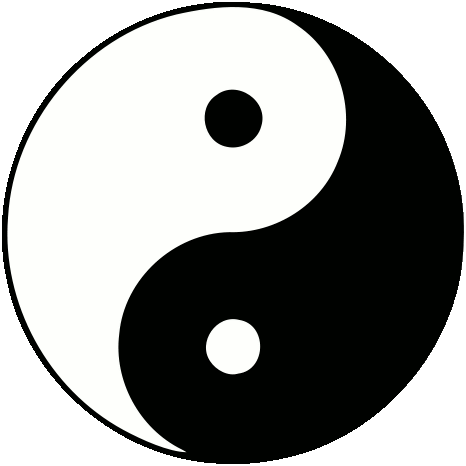There are various motivations we can focus on during our yoga asana practice, drawing our awareness to our physical body, or bringing our focus within, on a deeper energetic level.
 The Taoists hold the theory that there is a polarity of two energies that are ultimately inseparable. They can be understood as the + and – poles of existence. This philosophy is famously represented in the yin/yang symbol, a circle comprising two halves, one black side and one white separated with a S shape line, each side holding within it a dot of the opposite’s shade. The black side represents yin, the darker, deeper, hidden side and the white is a representation of yang, the energetic, brighter side. In the symbol they appear as separates, however, the S shape line that divides the two shades represents an eternal entwinement, a continuous flow into one another.
The Taoists hold the theory that there is a polarity of two energies that are ultimately inseparable. They can be understood as the + and – poles of existence. This philosophy is famously represented in the yin/yang symbol, a circle comprising two halves, one black side and one white separated with a S shape line, each side holding within it a dot of the opposite’s shade. The black side represents yin, the darker, deeper, hidden side and the white is a representation of yang, the energetic, brighter side. In the symbol they appear as separates, however, the S shape line that divides the two shades represents an eternal entwinement, a continuous flow into one another.
Hatha yoga reflects this theory of polarity, where ha = yang and tha = yin. Yang can be a understood to be the masculine side, holding heat, energy, power, expressed in the sun, whereas yin can be explained to be the feminine side, cooling and passive, communicated in the moon. We can acknowledge here that yang corresponds to our outer body and yin the inner body.
Relating this philosophy into our yoga practice, a yang asana sequence can be recognized as being a more dynamic session, focusing on breath and continuous movement, a practice that creates heat, energy and strength. A yin asana practice focuses more on softening the muscles, sinking deeply into each asana to reach the deep tissues of the body and stretching without engaging the muscles with more restorative and passive asanas.
Choosing a practice that you feel comfortable with is important as it allows you to focus your mind and open your body. However, I always believe that a practice does not need to be so regimented. I often change the rhythm of my sequence depending on my energy. Our bodies and moods change and flow and our asana practice should be a reflection, a complement to our bodies.
It is common to choose either a yin or yang based session depending on the time of day and the aim of your practice. You could follow a dynamic yang in the morning, beginning your day with sun salutations to wake the body and bring energy and movement to your joints. In the afternoon, you could choose a beautiful yin based sequence to calm the body and free the mind as the sun sets on the day.
During many of my asana sessions I enjoy combining yin and yang sequences, beginning with rhythmic yang movements to build heat and integrity – where we can lose ourselves in the movement of the body as we flow with the breath. This allows us to focus the mind by bringing the attention to our centre, our core.
Towards the end of the session the flow becomes gentler as it moves into a deeper practice of yin. Holding postures for a longer period of time as we allow ourselves to really surrender into each asana, our bodies will be more welcoming to the postures, our minds more alert. We can allow ourselves to meditate in each asana having full awareness of ourselves. Flowing through the yin sequence gently leads the mind and body into a relaxed state. The body cools, the breath deepens, creating a natural path into a final savasana (final relaxation).
During a yin/yang practice the body is taken on a journey, where you can lose yourself in movement before flowing into a deep meditative state of consciousness, an induced state of pratyahara (withdrawal), leaving your mind clear and your body open and relaxed. Just as it is represented within the yin yang symbol, balance and harmony can integrate with body, mind and spirit.
About the author |
 When she isn’t studying yoga in India or exploring the world, Emma Malarkey teaches at Azul Yoga & Pilates Retreat always bringing back new inspiration for the team and guests. Her wide ranging yoga experience means her personal practice and teaching style incorporates many different styles, including traditional hatha, tantra, Mysore ashtanga, sivananda, iyengar, vinyasa, and more modern forms such as yin yoga and Bikram. When she isn’t studying yoga in India or exploring the world, Emma Malarkey teaches at Azul Yoga & Pilates Retreat always bringing back new inspiration for the team and guests. Her wide ranging yoga experience means her personal practice and teaching style incorporates many different styles, including traditional hatha, tantra, Mysore ashtanga, sivananda, iyengar, vinyasa, and more modern forms such as yin yoga and Bikram. |